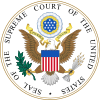New York v. Ferber
| New York v. Ferber | |
|---|---|

|
|
| Argued April 27, 1982 Decided July 2, 1982 |
|
| Full case name | New York, Petitioner v. Paul Ira Ferber |
| Citations | 458 U.S. 747 (more)
102 S. Ct. 3348; 73 L. Ed. 2d 1113; 1982 U.S. LEXIS 12; 50 U.S.L.W. 5077; 8 Media L. Rep. 1809
|
| Prior history | Defendant convicted at trial; conviction upheld by Appellate Division of the New York State Supreme Court. 74 App. Div. 2d 558, 424 N. Y. S. 2d 967 (1980); reversed by New York Court of Appeals, 52 N. Y. 2d, at 681, 422 N. E. 2d; certiorari granted, 452 U.S. 1052 |
| Subsequent history | Conviction affirmed |
| Holding | |
| State interest in protecting children allows laws prohibiting distribution of images of sexual performances by minors even where content does not meet tests of obscenity. | |
| Court membership | |
|
|
| Case opinions | |
| Majority | White, joined by Burger, Powell, Rehnquist, O'Connor |
| Concurrence | O'Connor |
| Concurrence | Brennan, joined by Marshall |
| Concurrence | Blackmun |
| Concurrence | Stevens |
| Laws applied | |
| U.S. Const. amend. I | |
New York v. Ferber, 458 U.S. 747 (1982), is a precedential decision given by the United States Supreme Court, which ruled unanimously that the First Amendment right to free speech did not forbid states from banning the sale of material depicting children engaged in sexual activity, even if the material was not obscene.
New York had an obscenity law that made it illegal for an individual to "promote any performance which includes sexual conduct by a child less than sixteen years of age." Paul Ferber, an owner of an adult bookstore in Manhattan, was charged under the law after he sold an undercover police officer two films depicting young boys masturbating. He was charged with promoting both obscene sexual performances and indecent sexual performances. At trial, he was acquitted of the obscene sexual performance count but he was convicted of the indecent sexual performance count, and the conviction was affirmed by the intermediate appellate court. The New York Court of Appeals overturned the conviction, finding the obscenity law unconstitutional under the First Amendment because the law was both underinclusive as to other films of dangerous activity, and overbroad as to its application to materials produced out-of-state and non-obscene materials.
The Court upheld the constitutionality of New York's obscenity law, ruling that it did not violate the First Amendment, and reversed and remanded the case.
For a long time before the decision, the Court had ruled that the First Amendment allowed the regulation of obscenity. Under the Court's previous decision in Miller v. California, 413 U.S. 15 (1973), material is "obscene" if, taken as a whole and applying contemporary community standards, it lacks serious scientific, literary, artistic, or political value, is "patently offensive" and aimed at "prurient interests". The court in Ferber found that child pornography, however, may be banned without first being deemed obscene under Miller for five reasons:
...
Wikipedia
